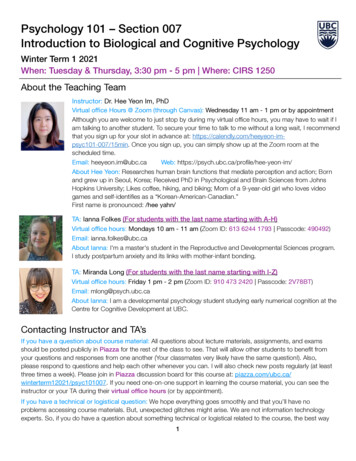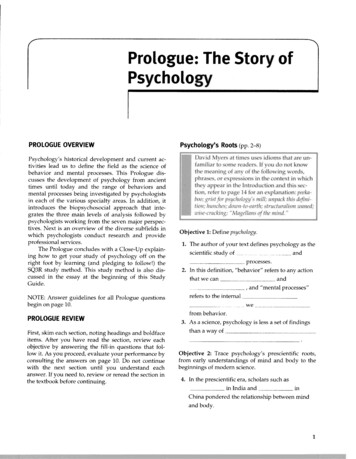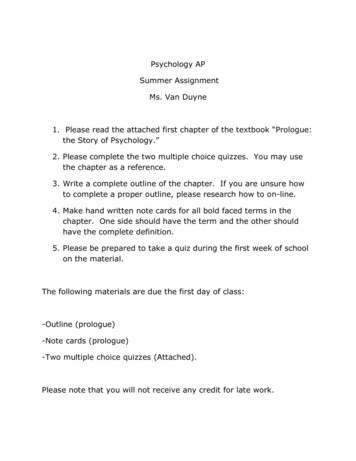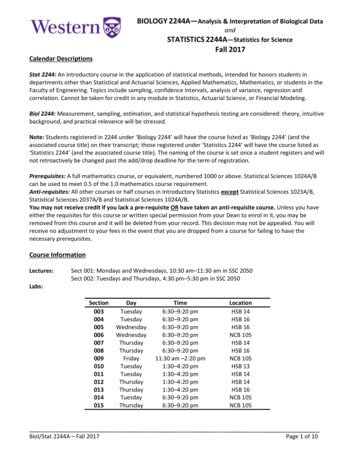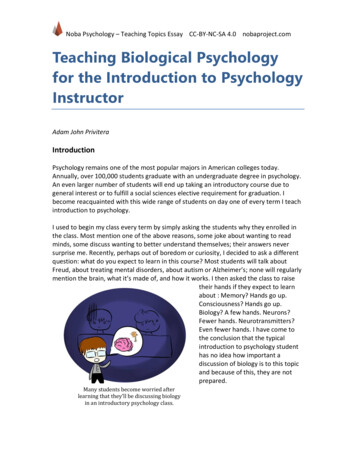
Transcription
Noba Psychology – Teaching Topics Essay CC-BY-NC-SA 4.0 nobaproject.comTeaching Biological Psychologyfor the Introduction to PsychologyInstructorAdam John PriviteraIntroductionPsychology remains one of the most popular majors in American colleges today.Annually, over 100,000 students graduate with an undergraduate degree in psychology.An even larger number of students will end up taking an introductory course due togeneral interest or to fulfill a social sciences elective requirement for graduation. Ibecome reacquainted with this wide range of students on day one of every term I teachintroduction to psychology.I used to begin my class every term by simply asking the students why they enrolled inthe class. Most mention one of the above reasons, some joke about wanting to readminds, some discuss wanting to better understand themselves; their answers neversurprise me. Recently, perhaps out of boredom or curiosity, I decided to ask a differentquestion: what do you expect to learn in this course? Most students will talk aboutFreud, about treating mental disorders, about autism or Alzheimer’s; none will regularlymention the brain, what it’s made of, and how it works. I then asked the class to raisetheir hands if they expect to learnabout : Memory? Hands go up.Consciousness? Hands go up.Biology? A few hands. Neurons?Fewer hands. Neurotransmitters?Even fewer hands. I have come tothe conclusion that the typicalintroduction to psychology studenthas no idea how important adiscussion of biology is to this topicand because of this, they are notprepared.Many students become worried afterlearning that they’ll be discussing biologyin an introductory psychology class.
Why aren’t students thinking about the biology of the brain when they take apsychology course? My suspicion is that they have spent their entire life being exposedto the stereotypes of what psychology supposedly is, not what it actually is. It is a hugewakeup call for an undergraduate to hear that part of studying human behavior andmental processes is learning about the organ that creates behavior and mentalprocesses. Truly, the prospect of learning biology in a social sciences course scares thehell out of them.Students are not alone in their fear of biology in a psychology course. Regularly, I meetfaculty that are openly uncomfortable discussing the biological aspects of behavior andmental processes during an introductory course. I’ve met some that completely skip thissection of the course! Why is that? Many instructors are simply not comfortablecovering a topic they didn’t explore in depth during their own graduate training. Itseems to be the case that most of the anxiety associated with covering this topic in anintroductory psychology class comes from one of two general misconceptions:1. A discussion of the biological basis of behavior and mental processes is an optionaltopic during an introductory course.2. An instructor needs to be trained extensively in biological psychology in order tocover the topic in an introductory class.Given the huge shift in research focus over the last few decades toward a more “hardscience” form of psychology, especially after the “decade of the brain”, it is no longerthe case that a discussion of biological psychology is an optional topic. Truly, it wasnever an optional topic. Without a discussion of biological psychology students wouldleave with a tremendous knowledge gap that is crucial for success in later courses,degree programs, and careers. Additionally, students would lose out on crucialknowledge and experience needed to critically evaluate the myriad articles that presentbiological psychological research in a scientifically inaccurate way. Many instructors canthink of at least one article from the Internet mentioned by a student that made themcringe.Instructor QualificationsRegarding qualification to teach this topic, the ability to discuss biological psychology ata level that is appropriate in an introductory course simply requires that an instructor becomfortable with the very basic tenets of the field. I look to the Society forNeuroscience for guidance on what the main learning objectives of a discussion ofbiological psychology should be. Some of the proposed learning objectives includeunderstanding the following:1. The brain is the body’s most complex organ2. Communication within the brain is electrical and chemical
3. Experience changes the nervous systemAn instructor need not teach themselves an entire new field in order to cover a chapterin an introductory course as this topic can be framed within the instructor’s field ofexpertise. It is expected that an instructorreviews current research trends in order toupdate their course content, but this does notconstitute a complete relearning of what wascovered during graduate school. Simply put,you are renewing your knowledge aboutbiological psychology in a way that can fit intoyour area of expertise. Clinical background?Discuss how drugs can be used to treatmental disorders by manipulating thechemicals the brain uses in communication.Social psychologist? Why not frame adiscussion about experience changing thenervous system around the negative effectsof social isolation? Neuroscientist? You’veThe idea of teaching biological psychologyduring an introductory course is enoughlikely already infused biological psychologyto terrify some instructors. I promiseinto every topic discussed in an introductorythere is nothing to be afraid of.course. Bravo.How to Talk About Biological PsychologyOnce it is clear that a baseline level of knowledge has been established and updated, theinstructor should spend their time describing these complex processes in a way that isrelatable for the student, and in a language they can understand. In any introductorycourse there is a new vocabulary that students must learn in order to discuss the topicsappropriately. While this is no different in psychology, a number of terms that are usedwhen describing biological psychology are very intuitive and are easy to get the hang ofafter a little bit of practice. Additionally, there are many terms that aren’t truly neededto introduce in order for the broader concepts to be discussed and mastered. Providingan appropriate amount of new vocabulary is a good first step before introducing aframework in which the students can use and master these new terms.In order to accommodate this excursion into uncharted territory I encourage the use ofa short preparatory writing assignment in which students are given a list of key termsand asked to define them using their own words. The assignment can be as simple asthe following:
To prepare for our discussion of biological psychology I would like you to conduct somebackground research (online and in your book) on specific areas of focus we will cover inclass. Please briefly summarize the following topics in your own words.1. The neuron.2. How communication occurs within a neuron.3. How communication occurs between neurons.4. The subdivisions of the nervous system and what they do (e.g. CNS, PNS, ANS,etc.).5. Pick one area of the brain (e.g. hippocampus) and describe what it is involved in.Reliably, a good chunk of these assignments will have huge flaws in the use ofterminology, descriptions of processes, and in demonstrating a clear understanding ofhow brain and behavior are connected. This should be expected; this is why thesestudents are taking your class! However, you have just done yourself and your studentsa huge favor: they have just engaged with a number of new concepts and terms that willnot be new to them during the subsequent class discussion.Anyone can cut and paste a definition from a book or a website but this does nothing tohelp in the understanding of new vocabulary. It is much easier to work within the mindof the individual student so they can frame things in a way that makes sense to them.Normally, I have students share their definitions in class so that everyone gets exposedto a range of perspectives on this new, scary vocabulary. I’ve learned that I can describesomething like a neurotransmitter five different ways and still have one or two studentsnot understand what it is. Students, in my experience, are the best translators ofcomplex terms into their own language. Why not use that to your advantage?After students are tracking on new terminology, it’s time to begin the difficult task ofdescribing what these things do and, more importantly, how they all interact in a way tocreate behavior and mental processes. Luckily, the majority of introductory topics inbiological psychology can be easily demonstrated during class time in a way that isinteractive, educational, and fun! Here are some of the most important topics to coverand strategies to help students understand them.Structure of the NeuronOne of the biggest misconceptions I address immediately when discussing biologicalpsychology relates to the structure of the neuron. Most students I encounter believethat neurons are plastic, rigid structures that are inflexible. Part of this might be relatedto a discussion of cytoskeletal structure, which could prime thoughts of bones foundelsewhere in the body. I blame the way in which neurons are depicted in popular
textbooks for this misconception. While some books do discuss the bi-lipid membranenature of the neuron, very few will describe what lipids are like. They aren’t plastic. Theyaren’t rigid. I find that illustrating how lipids interact with water can give the students amore realistic understanding of what the neuron is like structurally. While it might notbe the most scientifically accurate way of depicting this interaction, using a pipette orstraw to inject a drop of cooking oil in a bottle or glass of water can show students whathappens when a lipid based solution is added into an environment filled with water.Additionally, you can show students how a micropipette can be easily inserted into the“neuron” in order to measure polarity, steps that were crucial when first describing theaction potential.Taking a micropipettefrom your biologydepartment and insertingit into the floating bubbleof oil can illustrate howscientists measure thepotential of a neuron. Inthe event your biologydepartment doesn’t liketo share, you cansubstitute a strawalthough this methodlacks a certain degree ofSome basic equipment from your college’sscientific flair (remember,biology department along with some creativityyou are using a drop of oilcan provide students with a way of seeing howin a glass of water toscientists measure electrical potentials inneuronsrepresent a neuron so thestraw is likely not too far astretch at this point). If you want to get really technical, you can hook two micropipettesup to pieces of string and insert one into the bubble of oil and one outside the bubble.This is a great demonstration of how resting potential is measured in actual neurons.This demonstration works best if done in a small petri dish projected on a screen for theclass to see. To augment the experience, have this projection side by side with a pictureof a resting potential read-out. While the drop of oil does lack the cytoskeletal structurefound in real neurons it does provide an acceptable, hands-on way of giving students anidea what a neuron in like in the brain.Communication Within and Between NeuronsCommunication within the neuron (action potential) and between neurons(neurotransmission) are other concepts that students struggle understanding because itis hard to visualize what is being described verbally. Additionally, many textbook use
descriptions that give the impression that this process is a rigid process that sometimesresembles a key being inserted into a lock. These are lipids and proteins! There is nosolid, rigid lock and key to be found! A helpful demonstration can help remove some ofthese misconceptions and really drive home what the process is like.First, organize your class into two or three groups with the majority of studentsrepresenting sodium channels and a few as receptors. The organization should look likethe figure below with the Cs representing channels, the Bs representing the terminalbuttons and the Rs representing receptors.Note: the number of rows can be increased depending on how largeyour class is. You can also increase the number of students acting assodium channels.The passing of a note from one side of a classroom to another can allow for ademonstration of how sodium channels must open in one direction in order for thesignal to be sent down the axon. It is important to let the students know that the notecan only be passed in one direction. You can do this by instructing students to sit ontheir hands after they pass the note to the student next to them. This actually puts thestudent in an inactive state similar to that of the sodium channel’s refractory periodimmediately following depolarization and opening.When the note gets to the student acting as the terminal button, crumple it up and tossit to the student playing the receptor. This passage of the message across the synapticcleft demonstrates the process of neurotransmission. Having the “post-synaptic” groupof students attempt to catch the crumpled up note with their hands fixed into a fist, anopen hand that can’t close, and other positions can illustrate not only that the receptorsneed to be specialized, but that the receptors and neurotransmitters need to be able to
mold to one another. Remember, these are globular proteins. Neurotransmission is likea handshake between members of the same species, not really like a lock and key.This demonstration can be changed slightly to include coverage of inhibitorypostsynaptic potentials (IPSPs) and excitatory postsynaptic potentials (EPSPs). Writtenon the note that is being passed from one side of the classroom to the other can be thename of a known excitatory (e.g. glutamate) or inhibitory (e.g. GABA) neurotransmitter.It is then up to the student who is playing the role of the first channel whether or notthey are going to open or do nothing. This decision-making element continues to thenext group of students after the throwing of the note to the student playing the role ofthe receptor. What will that student tell the student sodium channel next to them todo? Open? Do nothing? This will be up to the student to decide based on theneurotransmitter they are told they are receiving. If you really want to make thingsinteresting, you can say that the students are located on neurons in a specific region ofthe brain and then ask them to predict what changes in behavior or mental processesmight occur as a consequence of the activity they acted out.The first question you likely have as an instructor after this demonstration is, “did mystudents get it?” I used to give a short, formative assessment after this demonstration inthe form of a short quiz. I quickly learned that this is a great way to assess whether ornot students are good at taking surprise quizzes. Recently, I began having a discussionwith the class centered on the following, or similar, questions: To the students who were sodium channels: what role did you play? What wasyour job?What was the passing of the note meant to represent?Why could you only pass the note in one direction?What happened when the note got to the end of the row of “channels”?To the students who were receptors: what role did you play? What was yourjob?What did it mean when you caught the crumbled up note?What happened when you were forced to hold your hand in a rigid shape?Additional questions can be added depending on how many different concepts you addto this demonstration. Ask the students to explain why they opened their channels ordid nothing. Have them explain why they predicted a certain behavioral change wouldoccur. Ask the students playing receptors why they told the student sodium channelsnext to them to open or do nothing. This normally provides a very interestingconversation that will allow you to see if any of this made sense to your students. Youcan end this activity by showing a video of the action potential and neurotransmission ina computer generated neuron and framing a discussion around how what was shown inthe video relates to the class activity.
The Role Myelin Plays in the Action PotentialAn effective way to illustrate this concept in any size class is by having the studentsengage in a modified “wave”. Covering this after introducing how the action potentialworks will allow for the students to make the connection between their movement “up”in the wave and the opening of a sodium channel during the propagation of an actionpotential. Having one student keep track of how long it takes for the wave to move fromone side of the class to another will give them a quantifiable thing to compare with the“myelinated” example.In order to do this demonstration, select astudent that has a stopwatch or cellphonewith stopwatch capabilities and have themcome to the front of the room. It isimportant that the student be able to seethe entire class. After this, explain to thestudents that they are going to beperforming “the wave” in class. For thosethat are unfamiliar, “the wave” is a popularactivity at sporting events. During thisactivity a column of spectators will all standup and lift their arms at around the sametime. Upon seeing this, the column ofThe wave, a popular activity duringsporting events, provides a great way topeople seated next to this group will liftdemonstrate the movement of an actiontheir arms and stand. The process ispotential down the axon of a neuron. Thisrepeated until movement has gone fromcan be modified to show how myelinone side of a stadium to the other. Theinfluences the action potential.movement, when performed correctly, givesoff the appearance of a wave. This is a fitting demonstration as the movement ofelectrical current down the axon of a neuron can be described as being wavelike.However, this wave will be slightly modified to illustrate an important concept with theaction potential: the refractory period. Students will stand and lift their arms but will beinstructed to sit on their hands after the completion of their movement. The student“channels” are in a refractory state and are unable to stand and lift their arms again.This illustrates two points: The action potential can only travel in one direction; andSodium channels close and cannot reopen during their refractory state.
After the class is on the samepage about what is expected ofthem, tell the first column ofstudents to begin on your signal.It is helpful to use a countdownto ensure that the timekeeperknows exactly when to start theclock. I would do a practice wavebefore actually recording thetimes; students will reliablybotch their first attempt. Afterthe class completes the firstround, write the first time on theboard and repeat the processtwo more times; use the averageof the three scores.Skipping over groups of students during the wave activitycan illustrate how myelin speeds up the action potential.Having a student time each group allows for the differencein time to be measured directly.Before illustrating the role ofmyelin in increasing the speed ofthe action potential, it is helpful to first describe how myelin prevents the axon fromneeding to repropagate the action potential at each step. This occurs because sectionsof the axon that are myelinated don’t leak like regular sections. Additionally, there areno sodium channels in the membrane of axon sections that are myelinated. Thisdemonstration is essentially the same as the previous with one difference: “the wave”will be skipping over a few columns of students at a time. Normally, I will tell the first,fourth, and seventh columns of students to participate in “the wave” as though thecolumns in-between them didn’t exist. This can be adjusted depending on the size of theclass you are teaching. To reduce the likelihood that students will accidentallyparticipate, I have those columns of students lay their arms flat on their desk. Again,having a student time this can give you a measurement to compare with the first time. Isuggest using an average of three measurements as well. Reliably, the example withfewer columns (the myelinated axon) will take less time because fewer “sodiumchannels” have to open. This is the way in which myelin increases the speed of theaction potential.Before moving on, I have a discussion with the class centered on a few main points tocheck that this demonstration achieved the desired goals: What did it represent when you stood up during “the wave”?What ion was allowed to enter the neuron when your channel was open?What happened to the channel next to you after your channel opened?What happened to you after you stood up during “the wave”? What did itrepresent?Could the wave move in more than one direction? Why/why not?
What happened when the axon was myelinated? Why did this happen?During this discussion students will be given a chance to explain what makes sense tothem and what doesn’t. In my experience, I don’t end up doing a lot of teaching duringthis discussion because the students who understand the example are very willing tospeak up and describe how it makes sense to them; many students enjoy helping eachother. By the end, most students report being comfortable with the idea of how theaction potential moves down an axon and how myelination increases the speed.Development of the Nervous SystemMost textbooks will describe the brain using three conventional subdivisions: forebrain,midbrain and hindbrain. Most students assume that this in reference to the first,second, and final third of the brain if you were to cut it from front to back. This meansthat the forebrain would contain the frontal lobe; the midbrain contains the parietal andpart of the temporal lobes leaving the hindbrain to contain the remainder of thetemporal and the entire occipital lobe. Given the way in which these subdivisions arenamed, this segregation makes sense! However, as psychology instructors, we know thisis incorrect, as the cortex and cerebrum together only constitute part of the forebrain.So how can we break this habit in our students? I have found that prefacing a discussionof the subdivisions of the brain with one that covers the development of the nervoussystem can help students see the reasoning for the misleading names and has decreasedincorrect usage of these names on writing assignments. Starting with the structure ofthe neural tube it’s very easy to see when these subdivision names made sense: thefront was the forebrain, the middle the midbrain, and the end was the hindbrain.Explaining to your students why the gross subdivisions of thebrain have their names from a developmental approach canhelp reduce the confusion. They made more sense at one point!But remember, theneural tube continues togrow and must fit withinthe skull. Much like anobject that barely fitsinto a container, thingsget squashed and movedaround in order to fit.Due to this process thesubdivision names thatmade sense at one pointno longer make sense.Drawing out how thesesubdivisions move canshow students wherethey exist in a mature,
developmentally typical brain. This can also be illustrated in class by bringing in a stuffsack or small container, and then an object that can barely fit into the stuff sack orcontainer. Students can clearly see that things get moved around when the containerthat holds an object imposes limits on size. This is essentially what happens to theneural tube as it is growing within the confines of the skull resulting in the subdivisionsof the brain being shifted in a way that makes their names misleading. Following thediscussion of brain subdivisions up with a few questions can allow you to informallyassess whether or not your students are on the same page. I find it helpful to just askstudents to explain what subdivision a random brain region belongs to and to have thestudents articulate why this is the case. Normally, seeing the neural tube fold in order tofit into the skull is sufficient to break down this misconception.Neuroanatomy and Brain FunctionNow that we have gotten over the misleading names of the subdivisions of the brain, itis possible to open a discussion about different areas in the brain and their function. It isimportant to avoid an approach that leads the student down a path believing that thebrain is made of distinct, independent “centers” that are specialized to do a singlefunction. While it is true that there is a degree of specialization for individual brainregions, it is not absolute.A great example of this emerges when discussing the fusiform face area (FFA). It istempting to assign every aspect of facial recognition to this one region; this is whatstudents tend to do. How soon they forget about the large collection of brain regionsinvolved in the processing of visual information at a very basic level. Describing an arealike this requires a discussion of the other regions that coordinate to provide the neededinformation to this structure. While it isn’t the case that the instructor needs to be ableto articulate the specific role that each region plays in the creation of complex visualperceptions, it is important that an attempt be made to solidify an understanding ofhow interconnected the brain is and how many regions interact to produce behaviorand mental processes.A helpful metaphor to illustrate how information is processed in the brain involvesdescribing a car going from one point to another on a map. Cars cannot teleport fromone place to another automatically, they need to drive on roads, across bridges, throughtunnels, and eventually they get to their destination. If the car represents the image ofyour best friend’s face processed by the retina in the back of the eye, and a randomlocation on the map represents where that information needs to go in order for it to beprocessed, students can clearly see that a number of different steps are involvedoutside of just the visual information (the car) and the FFA (the car’s destination). Willthe car be able to get to its destination if a road it needs to cross is out? No. What aboutif a bridge is out? No. What about if a tunnel the car doesn’t need to go through is out?Yes. In order for the car to get to its destination, all essential paths need to be intact.However, non-essential paths can be closed without impacting the car at all. This is the
same for the brain. In order for visual information to go from the retina to the FFA itmust pass through a number of interconnected regions until it gets to its finaldestination. If any of those paths are cut, the transmission of information is impactedjust like if a bridge a car needs to cross is out.Just like the initial framing of a discussion of biological psychology can be within therealm of an instructor’s area of expertise, introducing neuroanatomy can involvesticking to your strengths. The important things to discuss are less related to any specificregion of the brain and more about the general way the brain coordinates andintegrates signals across many regions and circuits. It’s never a good idea to overload astudent with different brain regions during an introductory course. Focusing ondeveloping an understanding of how any specific region works as part of an integratedwhole can prepare the student to apply what they have learned to any region of thebrain that is brought up during a later discussion or course.Behavioral GeneticsA topic that has somewhat recentlybeen introduced into the biologicalpsychology section of introductorytextbooks is a section on behavioralgenetics. This is another somewhatrecent hot topic in light modernadvances in the ability to gathergenetic information about oneself(e.g. 23andme, etc.). Similar to thepopular “science” articles coveringbreakthroughs in biologicalpsychology research, the role thatgenes play in behavior tends to begreatly exaggerated by the media.Even though they are genetically identical,these Pomeranian puppies behave in twodramatically different ways. What role did theenvironment play in this?Regularly, students will ask meabout the “cheating” gene, or the “aggression” gene, or some other gene thatpurportedly controls an entire behavior. Truthfully, as a student, I at one point assumedthis is how genes worked because of how often I read about them working in thismanner. Unfortunately, as we all know, this is not how genes work.As a psychology instructor, you might be the first and perhaps only exposure to thecentral dogma of molecular biology that a student encounters in college. A briefdiscussion of this topic can really drive a wedge between genes and behavior forstudents. While a discussion of DNA and RNA might throw a wrench in an otherwisestress-free discussion, an instructor can make a clear distinction between genes and
behavior using a less scary approach. A past instructor of mine, Dr. Mark Kristal, usedthree simple statements in order to illustrate the role that genes play in behavior:1. Genes have a profound effect on behavior.2. Genes do not have a direct effect on behavior.3. Genes do not have an exclusive effect on behavior.Regardless of whether or not a student understands the central dogma thesestatements give them a very clear understanding of how genes influence behavior. Itisn’t the case that there is a single gene for any behavior. Behavior is far toocomplicated. But, there are single genes that can influence behavior tremendously,although indirectly. Students need to remember that there are a number of steps thatexist between gene and protein so logically, there are even more steps between geneand behavior.Another misunderstanding students have has to do with the somewhat recentlyexpanding field of epigenetics. Most students I encounter assume that all genes arealways on, all the time. This ignores the huge body of research investigatingenvir
introductory psychology class comes from one of two general misconceptions: 1. A discussion of the biological basis of behavior and mental processes is an optional topic during an introductory course. 2. An instructor needs to be trained extensively in biological psychology

